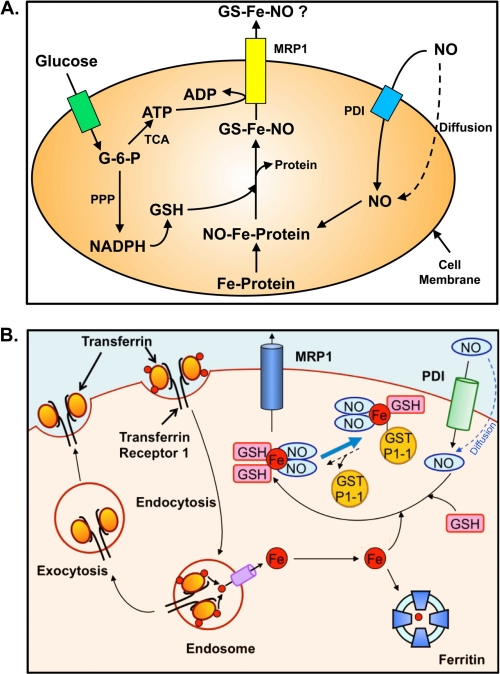FIGURE 2.
A, hypothetical model of d-glucose-dependent NO-mediated iron mobilization from cells. Studies using a variety of metabolizable and non-metabolizable sugars demonstrated that NO-mediated iron mobilization from cells is dependent on the transport of d-glucose into cells and its metabolism (39). Glucose is used by the tricarboxylic acid cycle for the production of ATP and by the pentose phosphate pathway (PPP) for the generation of NADPH, which is involved in the synthesis of GSH (39). NO either diffuses or is transported into cells by protein-disulfide isomerase (PDI) (100). Once within cells, NO intercepts and binds iron bound to proteins or iron that is en route to ferritin. The high affinity of NO for iron results in the formation of DNICs (represented here as GS-Fe-NO). GSH may either be involved as a reductant to remove iron from endogenous ligands and/or complete the iron coordination shell along with NO in the DNIC. This complex as an intact entity or its separate components can be released from the cell by an active process requiring MRP1. This model has been modified from Ref. 3. G-6-P, glucose 6-phosphate. B, schematic illustrating the respective roles of GST P1-1 and MRP1 in NO storage and transport. NO can diffuse through the membrane or may be actively transported into cells by protein-disulfide isomerase (100). Because of the ability of NO to act as a ligand, it can bind iron transported into cells and released from Tf. GSH completes the coordination sphere of the NO-iron complex to form a DNIC. DNICs can be bound by GST P1-1 or effluxed out of cells via MRP1 (37, 38).

